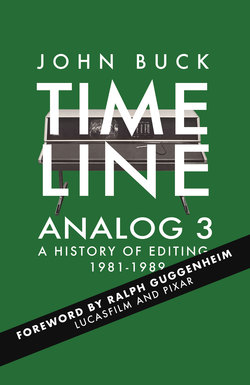Читать книгу Timeline Analog 3 - John Buck - Страница 13
На сайте Литреса книга снята с продажи.
FLM-1
ОглавлениеCMX began building a prototype of a semi-computerised film/video device called the Film Controller or FLM-1 (above). John Shike recalls:
Bob Duffy was always interested in coming up with a modern film editing device and he wanted to use CMX’s engineering capabilities to create the FLM-1. He imagined that film, not video machines, would be the source to feed a video editing controller and he decided to use Moviola’s Videola.
The 35mm film source material, be that dailies or rough film assemblies was loaded onto a Videola and recorded to a Sony 2868 deck to create a video ‘workprint’ to use for offline editing. During that process the FLM-1, which sat in between the two devices, would record the original film keycode/edge numbers and the related Sony’s timecode numbers at the point of transfer and then burn in this information as a window on the tape copy.
An editor could then use the visual codes or those stored by the FLM-1 to later create an assembly list for conforming a master with a standard CMX linear video suite. Of course CMX claimed that it could correlate frame counts from film-to-tape transfers with SMPTE timecode by running the film in constant synch with the U-matic deck but the in-built system to calculate the 3:2 pull down difference wasn’t very sophisticated so it could only track one editing session.
I thought it actually imposed the worst aspects of video upon film editing, in other words it made the whole film editing process a linear one - and not nonlinear as it normally is. And the advantages of video at the time, like instant opticals and effects, weren’t included in the package. Even though it wasn’t very successful, the FLM-1 acted as a catalyst for Bob Duffy to create a true nonlinear film and video system, the CMX-6000.
While Duffy's team worked away, CMX was in trouble. It had made an expensive move into satellite communications at the same time that competitors like ISC and Mach One had eroded its dominance of the post-production market. Financial World reported:
Orrox is pouring all of its profits and more from CMX into its Satcom division which is developing a receiver system for direct broadcast satellite transmission. Satcom executives had asserted that they would have a 3-foot dish for $500 on the consumer market by 1985. ... Marketed under the trademark CMX.
Dave Orr recalls:
Bill Orr was investing quite a deal of money into a company called Satcom to pioneer direct satellite broadcasting. It was way ahead of its time, inventing things which did not exist, including the market. Unfortunately the money was needed for editing systems research and development at CMX
William (Bill) Orr recalls:
I had a long term dream but it meant 'stepping on many crocodiles' to get there. I saw satellite communications as a much larger market opportunity than just making editing systems. The overall plan was to produce and create films and then distribute them via transponders that CMX/Orrox also made.
The press reported losses. Headlines read : CMX cannot survive Satcom.
When it became known publicly that CMX was in some trouble, other companies began to eye its assets. The titling equipment manufacturer Chyron knew that it needed to sell complete packages to its broadcast and post-production clients to remain competitive. The obvious product to align with was an editing solution and Chyron looked at CMX/Orrox as a potential target. CMX was in trouble, as was Atari.
Atari, now a subsidiary of Warner Comunications Inc., had geared its computer sales to the home market and had told investors it would be No.1 in home sales soon. However within months the so-called '1983 Games Crash' began and industry revenues of around $3.2 billion fell to around $100 million by 1985 (a drop of almost 97 percent).
There was now a steady stream of execs leaving Atari including Roger H. Badertscher, who left to set up a Mindset to produce a new personal computer.
